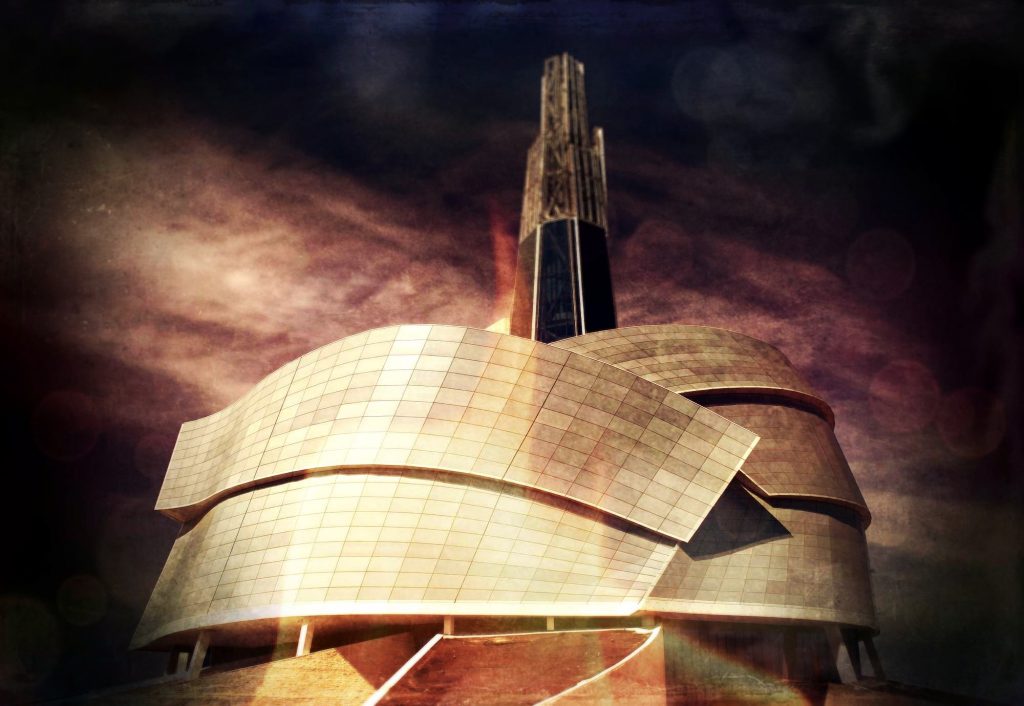
A Short Story
by
Mark Mallett
(First published February 21st, 2018.)
2088 A.D.... Fifty-five years after The Great Storm.
HE drew a deep breath as he stared at the oddly twisted, soot-covered metal roof of The Last Museum—named so, because it simply would be. Tightly closing his eyes, a flood of memories ripped open a cavern in his mind that had long been sealed… the first time he’d ever seen nuclear fallout… the ash from the volcanoes… the suffocating air… the black billowing clouds that hung in the sky like dense clusters of grapes, blocking the sun for months on end…
“Grampa?”
Her delicate voice snapped him from an overwhelming sense of darkness that he’d long not felt. He looked down into her bright, inviting face filled with a compassion and love that immediately drew tears from the well of his heart.
“Oh, Tessa,” he said, his nickname for the young Thérèse. Fifteen years old, she was like his very own daughter. He clasped her face in his hands and through watery eyes drank from the seeming endless abyss of goodness streaming from hers.
“Your innocence, child. You have no idea…”
Tessa knew this would be an emotional day for the man she called “Grampa”. Her actual grandfather had died in the Third War, and so, Thomas Hardon, now in his mid-nineties, assumed that role.
Thomas had lived through what became known as The Great Storm, a brief period some 2000 years after the birth of Christianity that culminated in “the final confrontation between the Church and the anti-church, the Gospel and the anti-gospel, between Christ and the Antichrist.” [1]Eucharistic Congress for the bicentennial celebration of the signing of the Declaration of Independence, Philadelphia, PA, 1976; cf. Catholic Online (confirmed by Deacon Keith Fournier who was in attendance
“That’s what John Paul the Great called it,” Grampa once said.
The survivors believed that they were now living in that period of peace foretold in the 20th chapter of Revelation, denoted by the symbolic number of a “thousand years.”[2]“Now… we understand that a period of one thousand years is indicated in symbolic language.” (St. Justin Martyr, Dialogue with Trypho, Ch. 81, The Fathers of the Church, Christian Heritage) St. Thomas Aquinas explained: “As Augustine says, the last age of the world corresponds to the last stage of a man’s life, which does not last for a fixed number of years as the other stages do, but lasts sometimes as long as the others together, and even longer. Wherefore the last age of the world cannot be assigned a fixed number of years or generations.” (Quaestiones Disputate, Vol. II De Potentia, Q. 5, n.5; www.dhspriory.org) After the fall of the “Dark One” (as Grampa called him) and the cleansing of the earth of the “rebellious”, a remnant of survivors began the rebuilding of a “greatly simplified” world. Tessa was the second generation to be born in this Era of Peace. To her, the nightmares her forefathers endured and the world they described seemed nearly impossible.
Which is why Grampa brought her to this museum in what was once known as Winnipeg, Canada. The dark, spiralling building was at one time the Canadian Museum of Human Rights. But as Grampa said, “‘Rights became death sentences.” In the first year after the Great Purification of the earth, he had inspired the idea for the museum for future generations to remember.
“I get a strange feeling here, Grampa.”
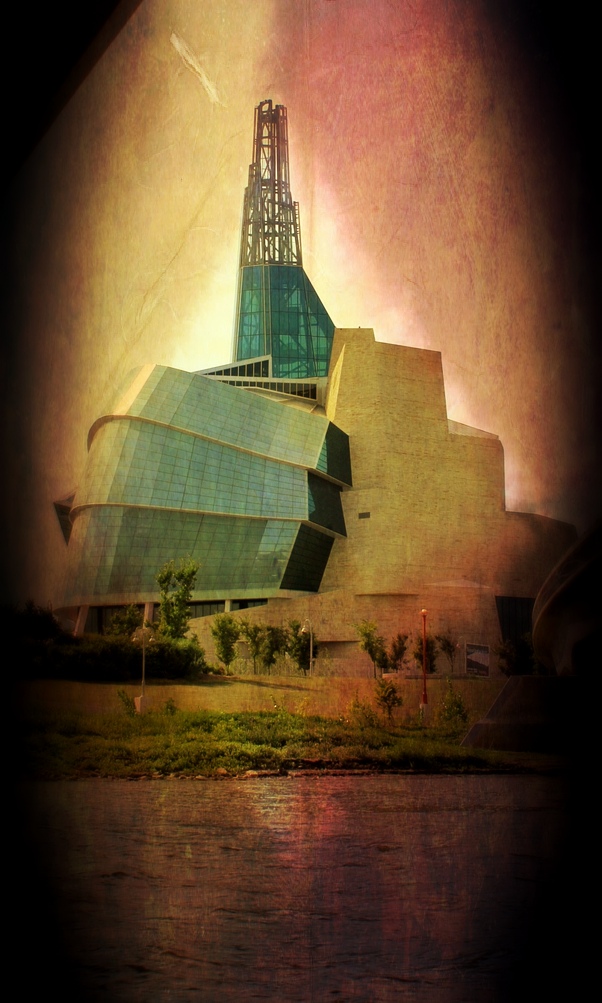 From a distance, the museum looked like drawings of the biblical “Tower of Babel,” a structure the ancients built out of arrogance in order to reach the “heavens,” hence, provoking God’s judgment. The United Nations also resembled that infamous tower, Thomas recalled.
From a distance, the museum looked like drawings of the biblical “Tower of Babel,” a structure the ancients built out of arrogance in order to reach the “heavens,” hence, provoking God’s judgment. The United Nations also resembled that infamous tower, Thomas recalled.
This building was chosen for a few reasons. First, it was one of the few large structures still intact. Much of the former United States to the south was decimated and uninhabitable. “Old Winnipeg,” as it was now called, was the new thoroughfare for pilgrims traveling from the Sanctuaries (the refuges where God shielded His remnant during the Purification). The climate here was now far milder compared to when Grampa was a kid. “It was the coldest place in Canada,” he often said. But after the Great Earthquake that tilted the earth’s axis,[3]cf. Fatima, and the Great Shaking Old Winnipeg was now closer to the equator, and the region’s once stark prairies were beginning to teem with lush foliage.
Second, the site was chosen to make a statement. Mankind had come to replace God’s commandments with “rights” that, having lost their basis in the natural law and moral absolutes, created an arbitrary order that tolerated everything but respected no one. It seemed fitting to turn this shrine into a pilgrimage site that would remind future generations of the fruits of “rights” when unhinged from the Divine Order.
“Grampa, we don’t have to go in.”
“Yes, yes we do, Tessa. You, and your children and your children’s children need to remember what happens when we turn from God’s commandments. Just as the laws of nature have consequences when not followed, so too do the laws of the Divine Will.”
Indeed, Thomas often pondered a third more ominous reason why The Last Museum came to be. For in the 20th chapter of Revelation, it goes on to speak of what happens after the period of peace…
When the thousand years are completed, Satan will be released from his prison. He will go out to deceive the nations at the four corners of the earth, Gog and Magog, to gather them for battle… (Rev 20:7-8)
How humans could forget the lessons of the past and rebel yet again against God was a source of debate among many of the survivors. The pestilence, evil, and poisons that once hung in the air, oppressing the soul, were gone. Nearly everyone, to one degree or another, was now a contemplative. The “Gift” (as it was called) of living in the Divine Will had so transformed souls that many felt as though they were already in Heaven, held back as though by a thread, anchored to their flesh.
And this new and divine holiness spilled over into the temporal order like the falls of a great river. Nature itself, once groaning under the weight of evil, had revived in places. Soil had become lush again in the habitable lands; the waters were crystal clear; the trees were bursting with fruit and the grain reached four feet high with heads nearly twice as long as in his day. And there was no more artificial “separation of Church and State.” The leadership were saints. There was peace… authentic peace. The spirit of Christ imbued everything. He was reigning in His people, and they were reigning in Him. The prophecy of a pope had come to fruition:
“And they shall hear my voice, and there shall be one fold and one shepherd.” May God… shortly bring to fulfillment His prophecy for transforming this consoling vision of the future into a present reality… It is God’s task to bring about this happy hour and to make it known to all… When it does arrive, it will turn out to be a solemn hour, one big with consequences not only for the restoration of the Kingdom of Christ, but for the pacification of… the world. We pray most fervently, and ask others likewise to pray for this much-desired pacification of society. —POPE PIUS XI, Ubi Arcani dei Consilioi “On the Peace of Christ in his Kingdom”, December 23, 1922
Yes, the pacification had come. But how could humanity ever turn its back on God again? To those who asked the question, Thomas would often reply with merely two words—and a sadness that alone spoke volumes:
“Free will.”
And then he would quote the Gospel of Matthew:
This gospel of the kingdom shall be preached in the whole world, for a testimony to all nations, and then shall the consummation come. (Matthew 24:14)
After all, the Tower of Babel was built a few hundred years after the first purification of the earth by the Flood, and even while Noah was still alive. Yes, they too forgot.
REMEMBERING
The dark entrance to the museum soon led to an open room softly lit by a few artificial lights.
“Wow, lights, Grampa.”
A lone curator approached them, an elderly woman in her late seventies. She explained that a few of the solar-powered lamps still worked, thanks to a former electrician who was familiar with the system in his day. As Tessa squinted at the barely lit walls, she could make out large photos of the faces of men, women, and children of different races and colors. Except for the images closer to the ceiling, most were damaged, kicked in, or spray-painted. The curator of the museum, noticing the girl’s curiosity, injected:
“Like most buildings that survived the Quake, they didn’t survive the anarchists.”
“What’s an anarchist?” Tessa asked.
She was a curious girl, witty and intelligent. She read and studied the few books that remained in the Sanctuaries and asked a lot of questions, most often when the elders used terms that were out of vogue. Once again, Thomas found himself studying her face… and her innocence. Blessed are the pure in heart. Oh, how her maturity dwarfed the fifteen-year-olds of his time—young men and women who had been brainwashed with revisionist history, dumbed-down by a constant flood of propaganda, sensual media, consumerism, and meaningless education. “God,” he thought to himself, “they turned them into animals to follow little more than their lowest appetites.” He recalled how so many were overweight and sickly looking, slowly poisoned by nearly everything they ate, drank, and breathed.
But Tessa… she practically glowed with life.
“An anarchist,” the curator responded, “is… or rather, was essentially someone who rejected authority, whether it was that of the government or even the Church—and worked to overthrow them. They were revolutionaries—at least they thought they were; young men and women with no light in their eyes, who respected no one and no thing. Violent, they were so violent…” She exchanged a knowing glance with Thomas.
“Feel free to take your time. You’ll find it helpful to carry a lamp,” she said, pointing to four unlit lanterns sitting on a small table. Thomas opened the small glass door of one of them as the curator 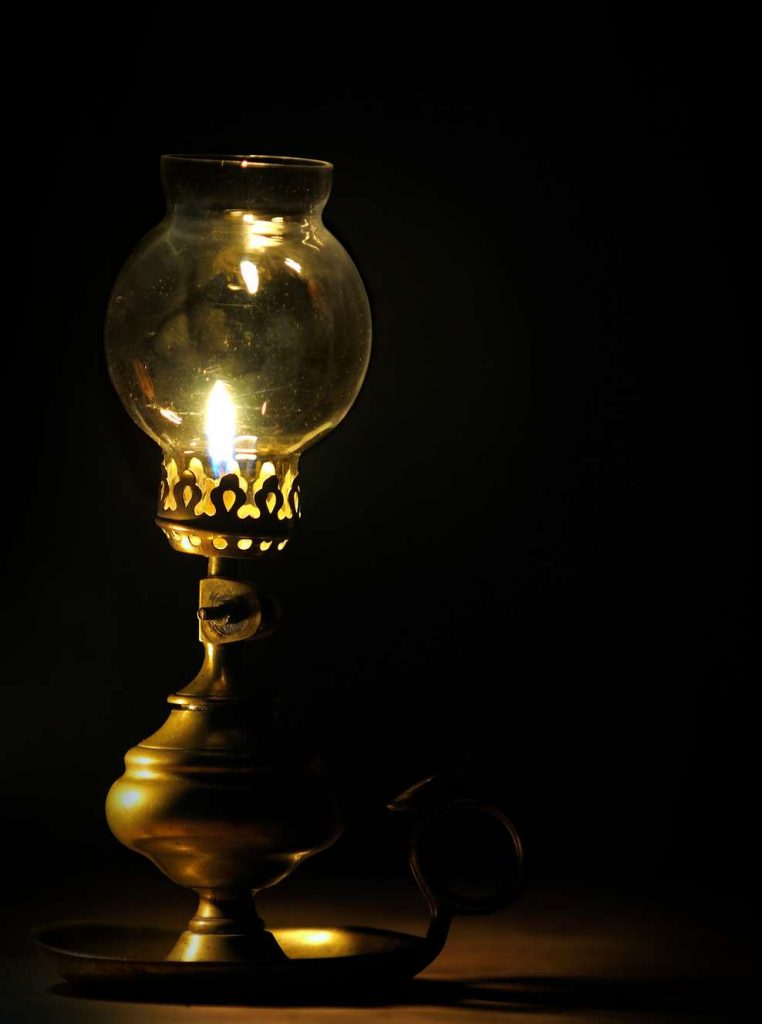 took a nearby candle, and then lit the wick inside the lantern.
took a nearby candle, and then lit the wick inside the lantern.
“Thank you,” said Thomas, slightly bowing to the woman. Noting her accent, he asked, “Are you an American?”
“I was,” she replied. “And you?”
“No.” He didn’t feel like talking about himself. “Bless you, and thank you again.” She nodded and motioned her hand to the first exhibit, one of several that lined the outer wall of the large, open room.
This was not a museum from Thomas’ childhood with interactive displays and moving parts. Not anymore. There were no pretensions here. Just a simple message.
They walked over to the first display. It was a simple wooden plaque with two candle sconces on either side. Script was neatly burned into its grain. Thomas leaned forward, holding the light of the lamp closer.
“Can you read that, dear?”
Tessa spoke the words slowly, prayerfully:
The eyes of the Lord are directed toward the righteous
and his ears toward their cry.
The Lord’s face is against evildoers
to wipe out their memory from the earth.
(Psalm 34:16-17)
Thomas quickly stood erect and released a deep sigh.
“It’s true, Tessa. Many said that Scriptures like these were mere metaphors. But they weren’t. Best we can tell, two-thirds of my generation are no longer on the planet.” He paused, searching his memory. “There’s another Scripture that comes to mind, from Zechariah:
In all the land, two-thirds of them will be cut off and perish, and one-third will be left. I will bring the one-third through the fire… I will say, “They are my people,” and they will say, “The Lord is my God.” (13:8-9)
After a few moments of silence, they walked to the next exhibit. Thomas gently grabbed her arm.
“Are you okay?”
“Yes, Grampa, I’m fine.”
“I think we’re going to see some tough things today. It’s not to shock you, but to teach you… to teach your children. Just remember, we reap what we sow. The last chapter of human history has yet to be written… by you.”
Tessa nodded. As they approached the next exhibit, the light of their lamp brightening the display, he recognized the familiar outline before him sitting on a small table.
“Ah,” he said. “It’s an unborn baby.”
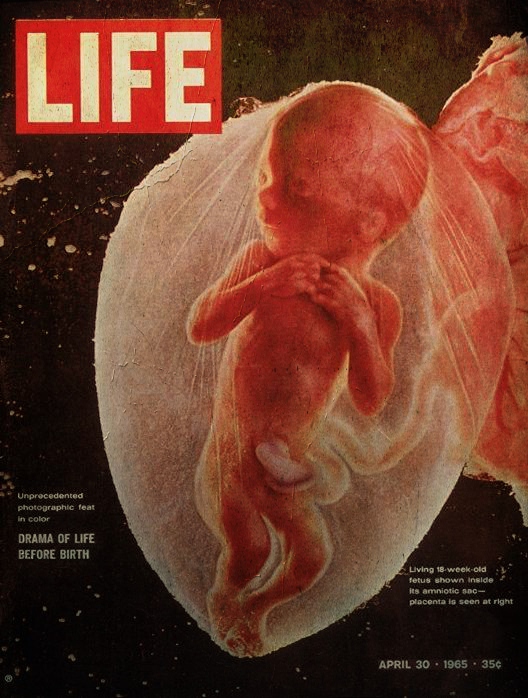 Tessa reached out and picked up what appeared to be an old laminated magazine with plastic coil binding. Her fingers brushed across the cover, feeling its smooth texture. The front cover read “LIFE” at the top in bold white letters on a red rectangle. Beneath the title was a photo of a fetus resting inside the womb of its mother.
Tessa reached out and picked up what appeared to be an old laminated magazine with plastic coil binding. Her fingers brushed across the cover, feeling its smooth texture. The front cover read “LIFE” at the top in bold white letters on a red rectangle. Beneath the title was a photo of a fetus resting inside the womb of its mother.
“It’s an actual baby, Grampa?”
“Yes. It’s a real photograph. Look inside.”
She slowly turned the pages that, through images, revealed the stages of life of the unborn. The warm light of the flickering lamp illuminated the wonder that crossed her face. “Ohh, this is amazing.” But as she reached the end of the magazine, a puzzled look came over her.
“Why is this here, Grampa?” He pointed to a small plaque hanging on the wall above the table. It simply read:
You shall not kill… For you created my inmost being;
you knit me together in my mother’s womb.
(Exodus 20:13, Psalm 139:13)
Her head jerked toward him with a questioning expression. She looked down at the cover, and then back again.
Thomas took a deep breath and explained. “When I was your age, governments around the world had declared that it was a ‘woman’s right’ to kill the baby within her womb. Of course, they didn’t call it a baby. They called it a ‘growth’ or a ‘blob of flesh’ — a ‘fetus.'”
“But,” she interrupted, “these pictures. Didn’t they see these pictures?”
“Yes, but—but people argued that the baby wasn’t a person. That only when the baby was born did it become 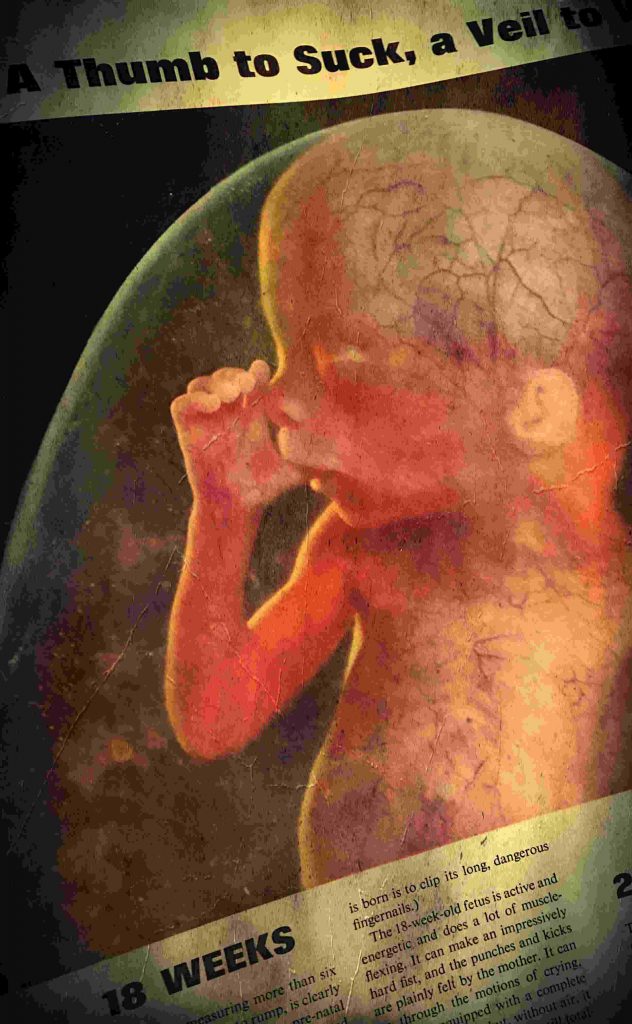 a person.”[4]cf. Is the Fetus a Person? Tessa opened the magazine again to look at the page where the child was sucking its thumb. Thomas looked carefully into her eyes and then continued.
a person.”[4]cf. Is the Fetus a Person? Tessa opened the magazine again to look at the page where the child was sucking its thumb. Thomas looked carefully into her eyes and then continued.
“There came a time when doctors would deliver the baby partway until only the head remained in its mother. And because it wasn’t ‘fully born,’ they would therefore say it was still legal to kill it.”
“What?” she exclaimed, covering her mouth.
“Before the Third War, close to two billion babies had been killed after only five to six decades.[5]numberofabortions.com It was something like 115,000 a day. It was this, many believed, that brought the Chastisement upon humanity. I do too. Because in truth,” he continued, pointing to the pink fetus on the magazine, “the only difference between you and that child is that it’s younger.”
Tessa stood motionless, her gaze locked on the face of the child before her. After a half minute or so, she whispered “Two billion”, gently replaced the magazine and began walking alone to the next exhibit. Thomas arrived a few moments later holding the lamp up to read the placard hanging on the wall.
Honor your father and mother.
(Ephesians 6:2)
On a wooden table was a suitcase machine with tubes running from it, and beside that, a few medical needles. Beneath those was another placard with the words “HIPPOCRATIC OATH” at the top. Underneath, Thomas recognized what appeared to be Greek text:
διαιτήμασί τε χρήσομαι ἐπ᾽ ὠφελείῃ καμνόντων
κατὰ δύναμιν καὶ κρίσιν ἐμήν,
ἐπὶ δηλήσει δὲ καὶ ἀδικίῃ εἴρξειν.
οὐ δώσω δὲ οὐδὲ φάρμακον οὐδενὶ
αἰτηθεὶς θανάσιμον, οὐδὲ ὑφηγήσομαι
συμβουλίην τοιήνδε:
ὁμοίως δὲ οὐδὲ γυναικὶ πεσσὸν φθόριον δώσω.
Beneath was a translation that Tessa read aloud:
I will use treatment to help the sick
according to my ability and judgment,
But never with a view to injury and wrongdoing.
Neither will I administer a poison to anybody
when asked to do so,
nor will I suggest such a course.
—3rd-4th century B.C.
She paused for a moment. “I don’t understand.” But Thomas said nothing.
“Grampa?” She turned to see a solitary tear streaming down his cheek. “What is it?”
“At the same time as they began killing the little ones,” he said, motioning to the last exhibit, “the 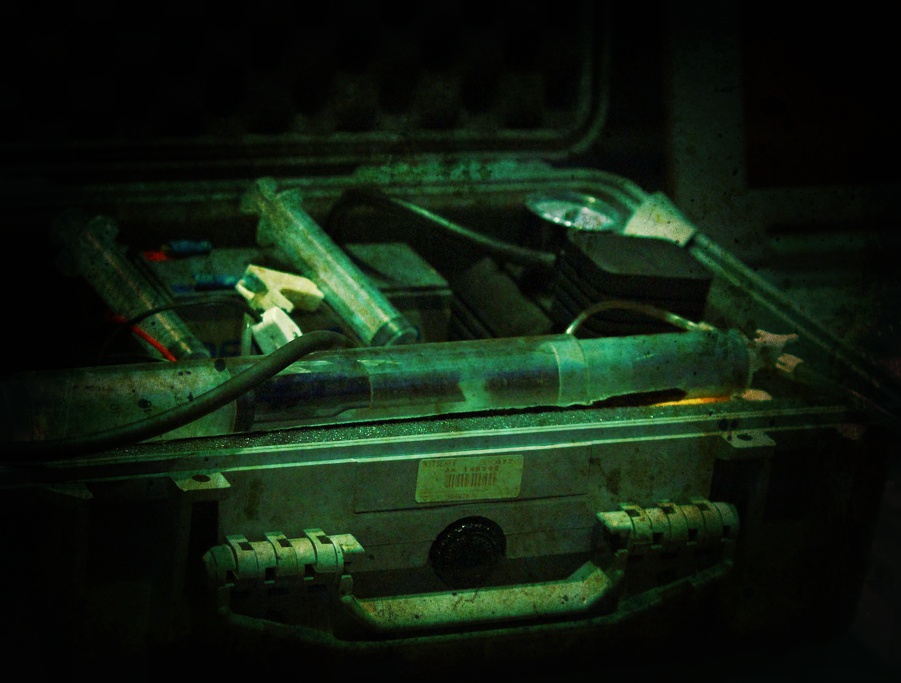 government began to allow people to kill themselves. They said it was their ‘right’.” Dipping his head toward the needles, he continued. “But then they forced the doctors to help them. In the end, though, doctors and nurses were eagerly taking people’s lives by injecting them with or without their consent—and not just the elderly,” he said, pointing at the commandment to Honor your father and mother. “They were killing the depressed, the lonely, the physically disabled, and eventually…” He looked at Tessa with severity. “Eventually they started to euthanize those who did not accept the New Religion.”
government began to allow people to kill themselves. They said it was their ‘right’.” Dipping his head toward the needles, he continued. “But then they forced the doctors to help them. In the end, though, doctors and nurses were eagerly taking people’s lives by injecting them with or without their consent—and not just the elderly,” he said, pointing at the commandment to Honor your father and mother. “They were killing the depressed, the lonely, the physically disabled, and eventually…” He looked at Tessa with severity. “Eventually they started to euthanize those who did not accept the New Religion.”
“What was that?” she interrupted.
“The ‘Dark One’ ordered that everyone must worship his system, his beliefs, even him. Whoever didn’t was taken to camps where they were ‘re-educated.’ If that didn’t work, they were eliminated. With this.” He looked down again at the machine and needles. “That was in the beginning. Those were the “lucky” ones. In the end, many were brutally martyred, as you might have heard.”
He swallowed hard and continued. “But my wife—Grandma—she fell one day and broke her ankle. She got a terrible infection and was stuck in the hospital for weeks and wasn’t getting any better. The doctor came in one day and said she should consider ending her life. He said it would be ‘best for everyone’ and that she was getting older anyway and that it was costing “the system” too much. Of course, we said no. But the next morning, she was gone.”
“You mean—”
“Yes, they took her, Tessa.” He wiped the tear from his face. “Yes, I remember, and I will never forget.” Then turning to her with a little smile, he said, “But I forgave.”
The next three displays were beyond Tessa’s comprehension. They contained photographs salvaged from books and the former museum archives. Emaciated and bruised humans, piles of skulls, shoes, and clothing. After 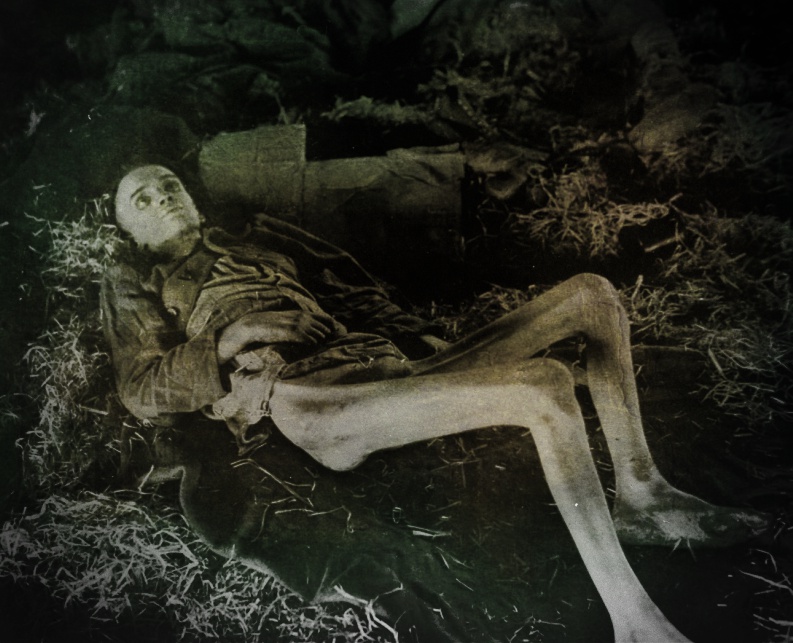 reading each placard, Thomas briefly explained the history of the Twentieth century’s slavery, the holocausts of Communism and Nazism, and at last the human trafficking of women and children for sex.
reading each placard, Thomas briefly explained the history of the Twentieth century’s slavery, the holocausts of Communism and Nazism, and at last the human trafficking of women and children for sex.
“They taught in the schools that God did not exist, that the world was created out of nothing but chance. That everything, humans included, was just the product of an evolutionary process. Communism, Nazism, Socialism… these political systems were ultimately just the practical application of atheistic ideologies that reduced humans to mere random particles of… chance. If that’s all we are, then why shouldn’t the strong control the weak, the healthy eliminate the sick? This, they said, was their natural ‘right.’”
Suddenly, Tessa gasped as she leaned toward a tattered photo of a small child covered in flies, his arms and legs as thin as tent poles.
“What happened, Grampa?”
“Powerful men and women used to say that the world was over-populated and that we didn’t have enough food to feed the masses.”
“Was it true?”
“No. It was bunk. Before the Third War, you could have fit the entire global population into the state of Texas or even the city of Los Angeles.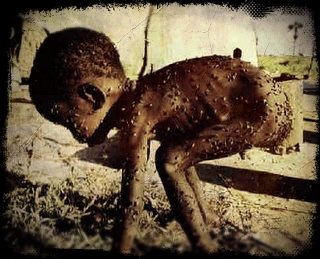 [6]“Standing shoulder-to-shoulder, the entire world’s population could fit within the 500 square miles (1,300 square kilometers) of Los Angeles.” —National Geographic, October 30th, 2011 Uh, Texas was… well, it was a very big state. Anyway, there was enough food to feed twice the world’s population. And yet…” He shook his head as he ran his calloused fingers across the swollen tummy on the photo. “Millions starved to death while we North Americans grew fat. It was one of the greatest injustices.[7]“100,000 people die from hunger or its immediate consequences every day; and every five seconds, a child dies from hunger. All of this takes place in a world that already produces enough food to feed every child, woman and man and could feed 12 billion people” —Jean Ziegler, UN Special Rapporteu, October 26th, 2007; news.un.org The lies. We could have fed them… but they had nothing to give us in turn, that is, crude oil. And so we let them die. Or we sterilized them. In the end, after the Third War, we were all hungry. I suppose that too was justice.”
[6]“Standing shoulder-to-shoulder, the entire world’s population could fit within the 500 square miles (1,300 square kilometers) of Los Angeles.” —National Geographic, October 30th, 2011 Uh, Texas was… well, it was a very big state. Anyway, there was enough food to feed twice the world’s population. And yet…” He shook his head as he ran his calloused fingers across the swollen tummy on the photo. “Millions starved to death while we North Americans grew fat. It was one of the greatest injustices.[7]“100,000 people die from hunger or its immediate consequences every day; and every five seconds, a child dies from hunger. All of this takes place in a world that already produces enough food to feed every child, woman and man and could feed 12 billion people” —Jean Ziegler, UN Special Rapporteu, October 26th, 2007; news.un.org The lies. We could have fed them… but they had nothing to give us in turn, that is, crude oil. And so we let them die. Or we sterilized them. In the end, after the Third War, we were all hungry. I suppose that too was justice.”
At that moment, Thomas realized that he hadn’t looked at Tessa for several minutes. He turned to find his sweet little girl frozen in an expression he’d never seen on her face. Her bottom lip quivered as tears overflowed onto her rosy cheeks. A strand of auburn hair stuck to her cheek.
“I’m so sorry, Tessa.” He put his arm around her.
“No…,” she said, shaking a little. “I’m sorry, Grampa. I can’t believe you lived through all of this.”
“Well, some of these things happened before I was born, but it was all part of the same train-wreck.”
“What exactly is a train again, Grampa?”
He chuckled and squeezed her tight. “Let’s keep going. You need to remember, Tessa.”
The next placard hung between two small statues of a nude man and woman covered tastefully in fig leaves. It read:
God created mankind in his image;
in the image of God he created them;
male and female he created them.
(Genesis 1:27)
Thomas himself puzzled for a moment as to what the display meant. And then he finally noticed the photos hanging on the wall to the left and right of the statues. As he held his lamp closer, Tessa let out a yelp. “What is that?”
She pointed to pictures of men in thick makeup wearing dresses and costumes. Others showed people in various undress on parade floats. Some people, painted in white, looked like nuns and another like a bishop. But one photo caught Thomas’s eye in particular. It was of a naked man strolling past bystanders, 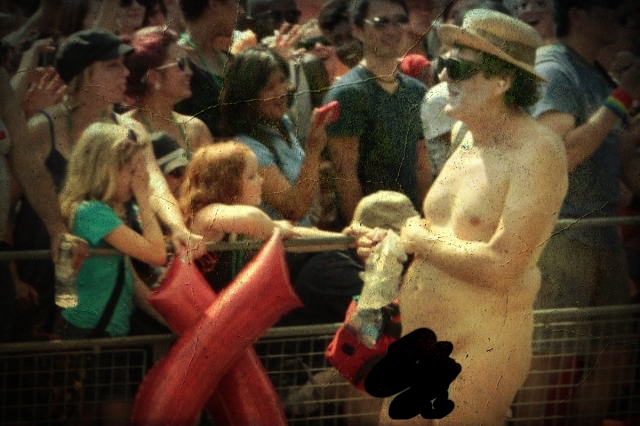 his private parts blotted out by a bit of ink. While several of the revelers seemed to be enjoying the spectacle, one young girl was covering her face, seemingly as astonished as Tessa.
his private parts blotted out by a bit of ink. While several of the revelers seemed to be enjoying the spectacle, one young girl was covering her face, seemingly as astonished as Tessa.
“In the end, we were a generation that no longer believed in God, and therefore, no longer believed in ourselves. What, and who we were, could then be redefined to be… anything.” He pointed to another photo of a man in a dog costume sitting beside his wife. “This guy identified as a dog.” Tessa laughed.
“I know, it sounds crazy. But it was no laughing matter. Schoolboys began to be taught that they might be girls, and little girls that they might grow up to be men. Or that they wouldn’t be men or women at all. Anyone who questioned the sanity of this was persecuted. Your Great Uncle Barry and his wife Christine and their kids fled the country when the authorities threatened to take their children away for not teaching them the State ‘sex education’ program. Many other families went into hiding, and yet others were torn apart by the State. The parents were accused of ‘child abuse’ while their kids were then ‘re-educated.’ Oh Lord, it was so messed up. I can’t even tell you the things that they brought into school rooms to teach innocent little boys and girls, some as young as five years old. Ugh. Let’s move on.”
They passed by one exhibit with several photos of people’s bodies covered in tattoos. Another exhibit had pictures of cracked soil and sickly plants.
“What’s that?” she asked. “It’s a crop-sprayer,” Grampa replied. “He’s spraying chemicals onto the food they grew.”
Another display showed shorelines of dead fish and vast islands of plastic and debris floating in the sea. “We just dumped our garbage into the ocean,” Thomas said. They moved on to another display where a single calendar hung with only six-day weeks and all Christian feast days removed. The placard read:
He shall speak against the Most High
and wear down the holy ones of the Most High,
intending to change the feast days and the law.
(Daniel 7:25)
At the next exhibit beneath the placard hung a photo of another magazine cover. It showed two identical babies looking at each other.
The Lord God formed man of the dust of the ground,
and breathed into his nostrils the breath of life;
and man became a living being.
(Genesis 2:7)
On the table were other photos of identical sheep and dogs, several other identical children, as well as pictures of other creatures she did not recognize. Beneath them, another placard read:
Verily no one of sound mind can doubt the issue of this contest
between man and the Most High.
Man, abusing his liberty, can violate the right
and the majesty of the Creator of the Universe;
but the victory will ever be with God—nay,
defeat is at hand at the moment when man,
under the delusion of his triumph,
rises up with most audacity.
—POPE ST. PIUS X, E Supremi, n. 6, Oct 4th, 1903
After reading the words aloud, Tessa asked what the whole display meant.
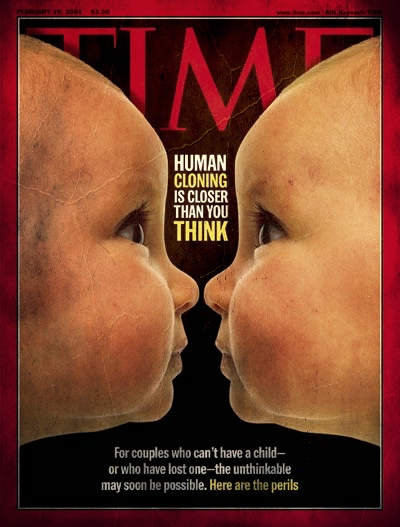 “If man no longer believes in God and no longer believes that he is created in God’s image, then what is stopping him from taking the place of the Creator? One of the most awful experiments on mankind was when the scientists began to clone human beings.”
“If man no longer believes in God and no longer believes that he is created in God’s image, then what is stopping him from taking the place of the Creator? One of the most awful experiments on mankind was when the scientists began to clone human beings.”
“You mean, they would… Um, what do you mean?”
“They found a way to create a human being without a father and mother in the natural way that God intended—through married love. They could, for instance, take cells from your body and, from those, create another you.” Tessa pulled back in astonishment. “In the end, they attempted to create an army of clones—super-human fighting machines. Or super-machines with human qualities. The lines between human, machine, and animal simply disappeared.” Tessa slowly shook her head. Thomas glanced at her drawn face, noting her disbelief.
At the next exhibit, she looked down at a large table of colorful boxes and wrappers and quickly figured out what they were. “Is that how food looked back then, Grampa?” The only food Tessa had every known was grown in the fertile valley that she called home (but the survivors called “Sanctuary”). Deep orange carrots, plump potatoes, large green peas, bright red tomatoes, succulent grapes… this was her food.
She’d heard the stories about “supermarkets” and “box stores,” but she’d only seen those kinds of foods once before. “Oh! I’ve seen that one, Grampa,” she said, pointing to a faded cereal box with a freckled, grinning boy slurping red, yellow, and blue chunks. “It was in that abandoned house near Dauphin. But what on earth is he eating?”
“Thérèse?”
“Yes?”
“I want to ask you a question. If people believed they were no longer made in God’s image and that there was no eternal life—that all that existed was the here and now—what do you think they would do?”
“Hm.” She glanced down at the curved bench behind her and sat on the edge. “Well, I suppose… I suppose they would simply live for the moment, trying to make the best of it, yes?”
“Yes, they would seek whatever pleasures they could and avoid whatever suffering possible. Do you agree?”
“Yes, that makes sense.”
“And if they did not hesitate to act like gods, creating and destroying life, altering their very bodies, do you think they would tamper with their food as well?”
“Yes.”
“Well, they did. There came a time when it was very difficult for any of us to find the kind of food that you now know.”
“What? No vegetables or fruits? No cherries, apples, oranges….”
“I didn’t say that. It was hard to find any food that wasn’t genetically modified, that scientists didn’t alter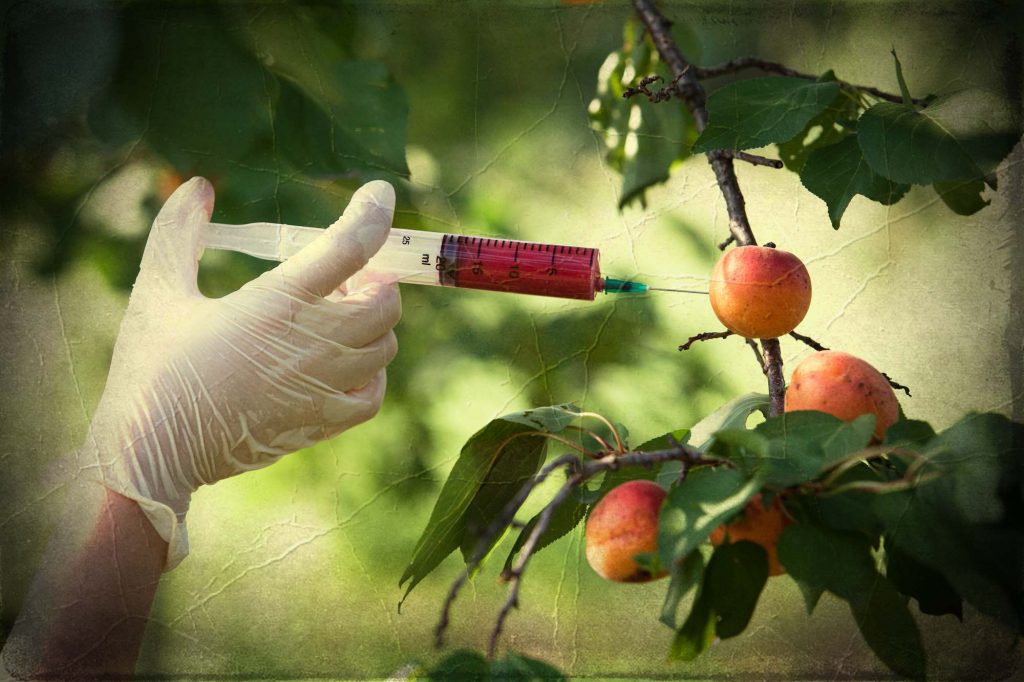 in some way to… look better, or be resistant to disease, or whatever.”
in some way to… look better, or be resistant to disease, or whatever.”
“Did it taste better?”
“Oh, not at all! Much of it tasted nothing like what we eat in the valley. We used to call it ‘Frankenfood’ which means… oh, that’s another story.”
Thomas picked up a candy bar wrapper, its contents replaced with Styrofoam.
“We were being poisoned, Tessa. People were eating foods laden with chemical from the farming practices at that time as well as toxins to preserve or flavor them. They wore makeup that was toxic; drank water with chemicals and hormones; they breathed polluted air; they ate all kinds of things that were synthetic, which means man-made. Many people got sick… millions and millions.… They became obese, or their bodies began to shut down. All kinds of cancers and diseases exploded; heart disease, diabetes, Alzheimers, stuff you’ve never heard of. You’d walk down the street and you could just see that people weren’t well.”
“So what did they do?”
“Well, people were taking drugs… we called them ‘pharmaceuticals.’ But this was only a band-aid, and often made people sicker. In fact, it was sometimes the very ones making the food who then made the drugs to treat those who were sick from their food. They were just adding poison to the poison in many cases—and made a lot of money doing it.” He shook his head. “Lord, we took drugs for everything back then.”
“Bring the light down here, Grampa.” She moved aside a box labeled “Wagon Wheels” that covered the placard on the table. She began to read:
The Lord God then took the man and settled him
in the garden of Eden, to cultivate and care for it.
The Lord God gave the man this order:
You are free to eat from any of the trees of the garden
except the tree of knowledge of good and evil.
(Genesis 2:15-17)
“Hm. Yes,” Thomas reflected. “God has given everything we need. Many of us began to rediscover this back in the day—things that you take for granted now—that the leaves, herbs, and oils in God’s creation heal. But even these the State tried to control if not outright ban.” Tossing the candy wrapper back onto the table, he muttered. “God’s food is best. Trust me.”
“Oh, you don’t have to convince me, Grampa. Especially when Aunt Mary cooks! Is it just me, or is garlic not the best?”
“And cilantro,” he added with a grin. “We still hope to find a stalk of that growing somewhere one of these days.”
But his face became somber again at the next exhibit.
“Oh, dear.” It was a photo of a child with a needle in her arm. He began to explain how when the pharmaceuticals called “antibiotics” were no longer working, everyone was ordered to take “vaccinations” against the diseases that were starting to kill thousands.
“It was terrifying. On the one hand, people were getting horribly sick, bleeding to death just by breathing 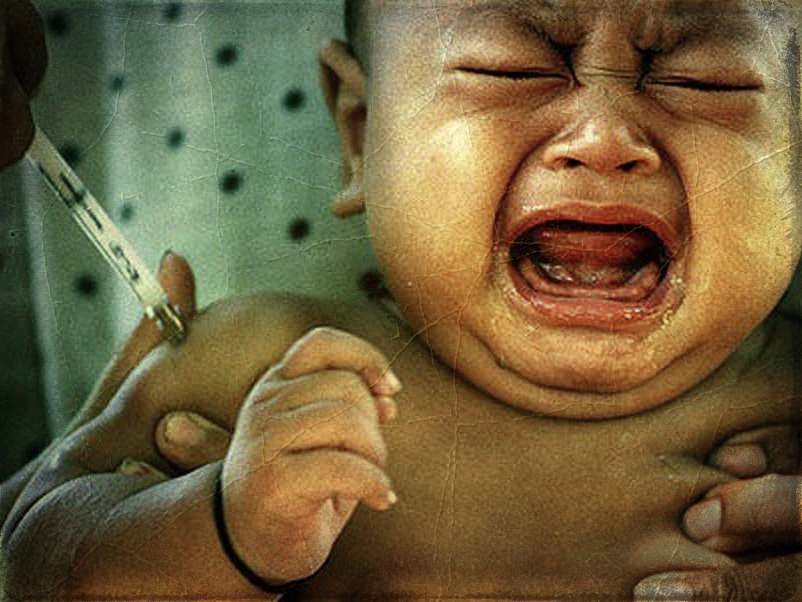 the viruses in the air. On the other hand, the forced vaccinations were causing terrible reactions in many people. It was either prison or roll the dice.”
the viruses in the air. On the other hand, the forced vaccinations were causing terrible reactions in many people. It was either prison or roll the dice.”
“What’s a vacc-in-ation?” she asked, over-pronouncing the word.
“They believed back then that if they injected people with the virus—well, a form of the virus—”
“What’s a virus?” Thomas stared blankly into her eyes. Sometimes he was taken aback at how little her generation knew of the destructive forces present in his childhood. Death was now rare, and only among the most aged survivors. He recalled the prophecy of Isaiah regarding the Era of Peace:
As the years of a tree, so the years of my people;
and my chosen ones shall long enjoy the produce of their hands.
They shall not toil in vain, nor beget children for sudden destruction;
for a race blessed by the Lord are they and their offspring.
(Isaiah 65:22-23)
Nor could he fully explain why he, compared to the ninety-some-year-olds he once knew, still had so much energy and was as agile as a sixty-year-old. While having a conversation on that very subject with priests from another Sanctuary, a young cleric pulled out a pile of old printed computer paper, dug through them for a minute, until he finally found the page he wanted. “Listen to this one,” he said with a glint in his eye. “This Church Father was referring, I believe, to our time:”
Also, there shall not be an immature one, nor an old man who does not fulfill his time; for the youth shall be of a hundred years old… — St. Irenaeus of Lyons, Church Father (140–202 A.D.); Adversus Haereses, Bk. 34, Ch.4
“If you don’t want to talk about it, that’s okay, Grampa.” Thomas jolted back to the present.
“No, sorry. I was thinking of something else. Where were we? Ah, vaccines, viruses. A virus is simply something really tiny that gets into your bloodstream and makes you sick.” Tessa contorted her nose and lips, making it clear she was a bit confused. “The point is this. In the end, it was revealed that a lot of the diseases that made people sick, most especially children, babies… came from injecting them with multiple vaccines that were supposedly to keep them from getting sick in the first place. By the time we realized what they were doing to the global population, it was too late.”
He held his lamp up. “What does the plaque say for this one anyway?”
The Lord is the Spirit, and where the Spirit of the Lord is,
there is freedom.
(2 Corinthians 3:17)
“Hmm,” he snorted.
“Why this Scripture?” she asked.
“It means that whenever we are forced to do something against our conscience, it almost always is a destructive force of Satan, that ancient liar and murderer. In fact, I can guess what the next exhibit will be….”
They had reached the final display. Tessa took the lamp and held it up to the placard on the wall. It was much larger than the others. She read slowly:
It was then permitted to breathe life into the beast’s image,
so that the beast’s image could speak and have
anyone who did not worship it put to death.
It forced all the people, small and great,
rich and poor, free and slave,
to be given a stamped image on their right hands or their foreheads,
so that no one could buy or sell except one
who had the stamped image of the beast’s name
or the number that stood for its name.
His number is six hundred and sixty-six.
(Revelation 13:15-18)
On the table below was a single photo of a man’s arm with a strange, small mark on it. Above the table, a large, flat black box hung on the wall. Beside it was mounted several smaller, flat black boxes of various sizes. She had never seen a television, computer, or cellphone before, and so had no idea what she was looking at. She turned to ask Thomas what it was all about, but he wasn’t there. She wheeled around to find him sitting down on the bench nearby.
She sat beside him, placing the lamp on the floor. His hands were cupped over his face as though he couldn’t look anymore. Her eyes scanned his thick fingers and neatly groomed fingernails. She studied a scar on his knuckle and the age mark on his wrist. She glanced at his full head of soft white hair and couldn’t resist reaching up to gently stroke it. She put her arm around him, leaned her head on his shoulder, and sat in silence.
The light from the lamp flickered on the wall as her eyes slowly adjusted to the dark room. Only then did she see the enormous mural painted above the display coming into view. It was of a Man on a white horse wearing a crown. His eyes flashed with fire as a sword jutted from His mouth. On His thigh were written the words, “Faithful and True” and upon His red cloak, trimmed in gold, “The Word of God”. As she squinted further into the darkness, she could see an army of other riders behind Him going up, up, towards the ceiling. The painting was extraordinary, like nothing she’d ever seen. It seemed living, dancing with each flicker of the lamp’s flame.
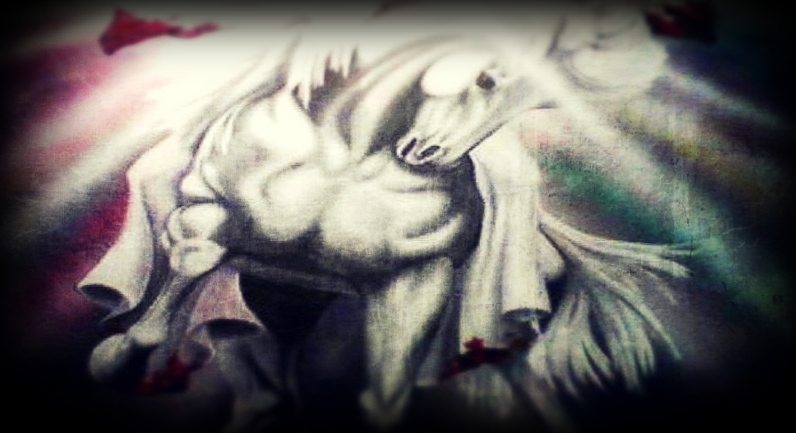
Thomas took a deep breath and folded his hands in front of him, with eyes fixed on the floor. Tessa straightened herself and said, “Look.”
He glanced to where she was pointing and, with his mouth slowly opening in awe, took in the specter before him. He began to nod his head and quietly laugh to himself. Then words from deep within began to spill out in a quivering voice. “Jesus, Jesus, my Jesus… yes, praise you, Jesus. Bless you, my Lord, my God and my King….” Tessa quietly joined his praises and began to weep as the Spirit fell upon them both. Their spontaneous prayer eventually simmered and, once again, they sat in silence. All the toxic images she had earlier seen just seemed to melt away.
Thomas exhaled from the core of his soul and began to speak.
“The world was falling apart. War had broken out everywhere. The explosions were terrible. One bomb would drop, and a million people were gone. Another would drop and yet another million. Churches were being burned to the ground and the priests… Oh God… they had nowhere to hide. If it wasn’t the Jihadists, it was the anarchists; if it wasn’t the anarchists, it was the police. Everyone wanted to kill or arrest them. It was chaos. There were food shortages and, as I said, disease everywhere. Every man for himself. It was then that the angels led several of us to the temporary refuges. Not every Christian, but many of us.”
Now, while in Thomas’ youth, any fifteen-year-old who heard that someone was seeing angels would think you were either a quack or would riddle you with a hundred questions. But not Tessa’s generation. The saints often visited souls as did the angels. It was as though the veil between heaven and earth had been pulled back, at least a bit. It made him think of that Scripture in the Gospel of John:
Amen, amen, I say to you, you will see the sky opened and the angels of God ascending and descending on the Son of Man. (John 1:51)
“To survive, people fled the cities, which became open battlegrounds between roving gangs. The violence, rape, murder… it was horrible. Those who escaped formed guarded communities—heavily armed communities. Food was scarce, but at least people were safe, for the most part.
“It was then that he came.”
“Him?” she said, pointing to the mural.
“No, him.” He pointed to the base of the painting where the feet of the white horse rested atop a small globe with the number “666” painted on it. “He was the ‘Dark One’, as we called him. Antichrist. The Lawless One. The Beast. The Son of Perdition. Tradition has many names for him.”
“Why did you call him the Dark One?”
Thomas let go a small, uncomfortable laugh, followed by a sigh, as though he were grappling to understand his thoughts.
“Everything was falling apart. And then he came. For the first time in months and months, there was peace. Out of nowhere, this army dressed in white came with food, clean water, clothing, even candy. Electric power was restored in some regions, and huge screens were set up in places—like that one on the wall, but much bigger. He would appear on those and speak to us, to the world, about peace. Everything he said sounded right. I found myself believing in him, wanting to believe in him. Love, tolerance, peace… I mean, these things were in the Gospels. Didn’t Our Lord simply want us to love one another and stop judging? Well, order was restored, and the violence quickly ended. For a time, it seemed as though the world was going to be restored. Even the skies were miraculously beginning to clear for the first time in months. We began to wonder if this was not the beginning of the Era of Peace!”
“Why didn’t you think so?”
“Because he never mentioned Jesus. Well, he did quote him. But then he quoted Muhammad, Buddha, Gandhi, St. Teresa of Calcutta, and  many others. It was so confusing because you couldn’t argue with… with the truth. But then…” Pointing at the lantern on the floor, he continued. “Just as that flame brings light and warmth to this room, it is still only a fraction of the spectrum of light, of a rainbow, for instance. So too, the Dark One could give just enough light to comfort and warm us—and settle down our growling stomachs—but it was only a half-truth. He never spoke of sin except to say that such talk only divided us. But Jesus came to destroy sin and take it away. That’s when we realized that we could not follow this man. At least some of us.”
many others. It was so confusing because you couldn’t argue with… with the truth. But then…” Pointing at the lantern on the floor, he continued. “Just as that flame brings light and warmth to this room, it is still only a fraction of the spectrum of light, of a rainbow, for instance. So too, the Dark One could give just enough light to comfort and warm us—and settle down our growling stomachs—but it was only a half-truth. He never spoke of sin except to say that such talk only divided us. But Jesus came to destroy sin and take it away. That’s when we realized that we could not follow this man. At least some of us.”
“What do you mean?”
“There was a great division among many of the Christians. Those whose god was their stomach accused the rest of us of being the real terrorists of peace, and they left.”
“And then what?’
“Then came the Edict of Peace. It was a new constitution for the world. Nation after nation signed onto it, handing their sovereignty over completely to the Dark One and his council. Then, he forced everyone….”
Tessa’s voice joined his as she read from the placard.
…small and great,
rich and poor, free and slave,
to be given a stamped image on their right hands or their foreheads,
so that no one could buy or sell except one
who had the stamped image of the beast’s name
or the number that stood for its name.
“So, what happened if you didn’t take the mark?”
“We were excluded from everything. From buying fuel for our cars, food for our children, clothes for our backs. We couldn’t do anything. At first, people were terrified. So was I, to be honest. Many took the mark… even bishops.” Thomas looked up into the ceiling that was as black as night. “Oh Lord, have mercy on them.”
“And you? What did you do, Grampa?”
“Many Christians went into hiding, but it was useless. They had the technology to find you anywhere. Many heroically gave up their lives. I watched one family of twelve children put to death before their parents, one by one. I’ll never forget it. With each blow to their child, you could see the mother pierced to the depth of her soul. But the father… he kept telling them in the most tender voice, ‘I love you, but God is your Father. Soon, we will see Him together in Heaven. In one more moment, child, one more moment…’ It was then, Thérèse, that I was ready to give my life for Jesus. I was just seconds from leaping from my hiding place to give myself up for Christ… when I saw Him.”
“Who? The Dark One?”
“No, Jesus.”
“You saw Jesus?” The way she asked the question betrayed the depth of her love for Him.
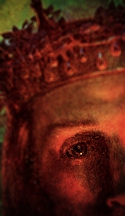 “Yes. He stood before me, Tessa—exactly as you see Him dressed there.” She returned her gaze to the mural as tears welled up in her eyes.
“Yes. He stood before me, Tessa—exactly as you see Him dressed there.” She returned her gaze to the mural as tears welled up in her eyes.
“He said, ‘I give you a choice: To wear the martyr’s crown or to crown your children and your children’s children with the knowledge of Me.’”
With that, Tessa burst into sobs. She collapsed onto Grampa’s lap and wept until her body heaved in deep breaths. When at last all became still, she sat up and looked into his deep, tender eyes.
“Thank you, Grampa. Thank you for choosing us. Thank you for the gift of Jesus. Thank you for the gift of knowing Him who is my Life and my Breath. Thank you.” They locked eyes, and for a moment, all they could see was Christ in the other.
Then, looking down, Tessa said, “I need to make a confession.”
Bishop Thomas Hardon stood up, took out the pectoral Cross from beneath his sweater, and kissed it. Removing the purple stole from his pocket, he kissed it also and placed it over his shoulders. Making the Sign of the Cross, he sat down again and leaned toward her as she whispered in his ear. He thought to himself how confessing such a small sin—if it even was a sin—would have drawn the scorn of a hardened priest. But no. This Era was the time of the Refiner’s Fire. It was the hour for the Bride of Christ to be made perfect, without spot or blemish.
Thomas rose again, laid his hands upon her head and bent over until his lips barely touched her hair. He whispered a prayer in a tongue she did not know and then pronounced the words of absolution as he traced the Sign of the Cross above her. He took her hands, raised her into his arms, and held her tightly.
“I’m ready to go,” he said.
“Me too, Grampa.”
Thomas blew out the lamp and placed it back on the table. As they turned toward the exit, they were greeted by a large sign above, illumined by twelve candles.
In the tender compassion of our God,
the dawn from on high has broken upon us,
to shine on those who dwell in darkness and the shadow of death,
and to guide our feet into the way of peace…
Thanks be to God who gives us the victory
through our Lord Jesus Christ.
(Luke, 1:78-79; 1 Corinthians 15:57)
“Yes, thanks be to God,” Thomas whispered.
To journey with Mark in The Now Word,
click on the banner below to subscribe.
Your email will not be shared with anyone.
Footnotes
| ↑1 | Eucharistic Congress for the bicentennial celebration of the signing of the Declaration of Independence, Philadelphia, PA, 1976; cf. Catholic Online (confirmed by Deacon Keith Fournier who was in attendance |
|---|---|
| ↑2 | “Now… we understand that a period of one thousand years is indicated in symbolic language.” (St. Justin Martyr, Dialogue with Trypho, Ch. 81, The Fathers of the Church, Christian Heritage) St. Thomas Aquinas explained: “As Augustine says, the last age of the world corresponds to the last stage of a man’s life, which does not last for a fixed number of years as the other stages do, but lasts sometimes as long as the others together, and even longer. Wherefore the last age of the world cannot be assigned a fixed number of years or generations.” (Quaestiones Disputate, Vol. II De Potentia, Q. 5, n.5; www.dhspriory.org) |
| ↑3 | cf. Fatima, and the Great Shaking |
| ↑4 | cf. Is the Fetus a Person? |
| ↑5 | numberofabortions.com |
| ↑6 | “Standing shoulder-to-shoulder, the entire world’s population could fit within the 500 square miles (1,300 square kilometers) of Los Angeles.” —National Geographic, October 30th, 2011 |
| ↑7 | “100,000 people die from hunger or its immediate consequences every day; and every five seconds, a child dies from hunger. All of this takes place in a world that already produces enough food to feed every child, woman and man and could feed 12 billion people” —Jean Ziegler, UN Special Rapporteu, October 26th, 2007; news.un.org |


